UltraHuman Ring Air review: it’s lighter than the Oura Ring, but is it better?
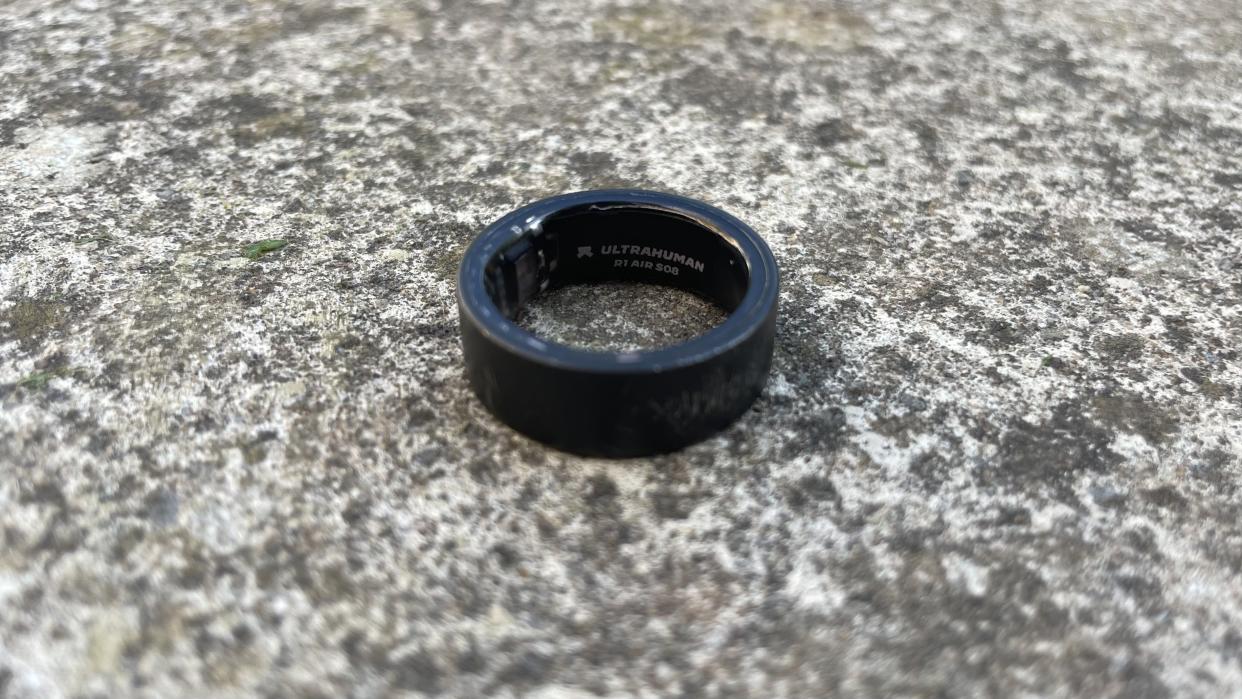
UltraHuman Ring Air: One minute review
The UltraHuman Ring Air is a smart ring. It’s lined with sensors that sit against your skin and measure your biometric data 24/7. Like other activity trackers, you can view this data whenever you like, but there’s a focus on recovery within the UltraHuman app. I found this incredibly helpful as I’m very active, but often have a tough time regulating my energy levels.
The UltraHuman Ring Air isn’t the only smart ring you can buy. Over the years many startups have started making smart rings, but many encountered problems with funding, legal issues, as well as design challenges – the tiny design doesn’t give you much space to pack in the necessary tech.
The Oura (Gen 3) ring is the top dog at the moment. The brand has been going from strength to strength since its first ring was released back in 2015 – fans allegedly include a bunch of celebs and athletes. UltraHuman entered the market much later in 2022 with its first original UltraHuman Ring. And more rivals are expected soon, like the Circular Ring, and there are even rumours that big tech brands are experimenting with this form factor, too, with a Samsung Galaxy Ring allegedly on the cards.
My biggest issue with smart rings is they’re so different. How do you know whether you’ll enjoy wearing one? Despite thinking the UltraHuman Ring Air looked a little bulky when I first tried it on, it’s incredibly light at only 2.4g, which made it very comfortable to wear, even at night.
The only design flaw is that the ring got scratched after a few weeks of wear. I mostly put this down to lifting weights while wearing it. But I’d expect it to handle a few deadlifts. This will put off those who like their accessories to be pristine because mine definitely lost much of the lovely matte black finish it came with.
Sensor-wise, there’s a lot packed into a small space here. There’s a PPG sensor to monitor circulation, a skin temperature sensor, motion sensors and a bunch of LEDs to track your heart rate and (soon) oxygen saturation. Some key data is missing that you’d find with other high-end wearables, like respiratory rate and VO2 max, but UltraHuman promises both of those are coming in an August update soon.
Because the UltraHuman Ring Air collects and interprets so much data, it’s aimed at those who are serious about training and finding out about how they’re performing and how to optimize in all sorts of areas – whether that’s working out or sleeping. If you don’t care about masses of data, look elsewhere.
Ultimately, we’re wary about recommending a device that’s going to be unlike other wearables you’ve tested. There’s certainly a chance you just won’t like wearing a smart ring. But if you’re willing to try one and you’re looking for genuinely useful insights, it’s a solid option. Read on to find out more about what I thought of the UltraHuman Ring Air.
UltraHuman Ring Air: Price and availability
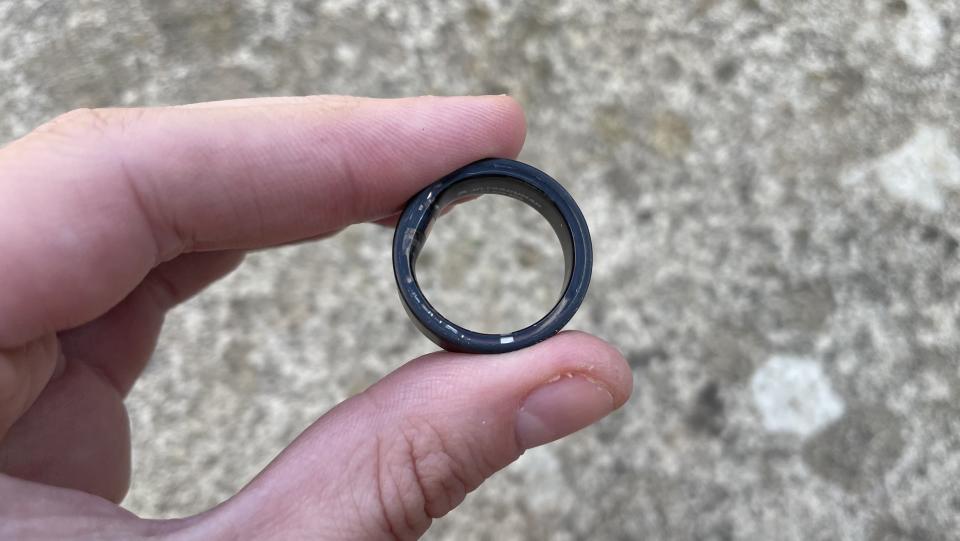
$349 / £280 / about AU$537
Released June, 2023
The UltraHuman Ring Air costs $349 / £280 / about AU$537 and was released in June, 2023.
It’s very difficult to compare this pricing to other wearables. For example, it’s certainly cheaper than the Apple Watch Series 8 at $399 / £419 / AU$629, which collects a similar amount of data. But you’re getting a screen and all sorts of other features with the Apple Watch there. It’s also way more expensive than more budget-friendly trackers that collect large amounts of data but do look a little basic, like the Fitbit Inspire 3 at $99.95 / £84.99 / AU$177.
It makes sense to compare the price to a device like the Whoop 4.0, which may be designed for your wrist but also doesn’t have a screen and is all about that data. But even that’s tricky because it’s based on a subscription model. A 24-month subscription is £16 a month, but you’ll need to pay that upfront as £384. An annual subscription is £19.08 a month, which is £229 upfront.
If this makes you nervous, we get it. But as much as we hate being tied into subscriptions, the benefit is that members can upgrade to the latest generation of hardware when it’s launched.
Of course, the most obvious comparison is the Oura (Gen 3) Ring that costs $299 / about £230 / AU$420. This includes a six-month Oura membership. Once that expires, you’ll need to pay $5.99 / about £4.50 / AU$8 per month to maintain your subscription if you want to keep access to premium features.
The upshot here is that, for the amount of data the UltraHuman Ring Air collects, it’s certainly competitively priced. And appealing if you have subscription fatigue and don’t fancy a membership from Oura or Whoop.
Does that make it good value? Yes and no. You can definitely get similar results from a cheaper device, but this is a lot of fantastic tech packed into a tiny and comfortable form factor. We think the price does make a lot of sense, but it is, as yet, still relatively uncharted territory.
Value score: 4/5
UltraHuman Ring Air: Specifications
UltraHuman Ring Air: Design
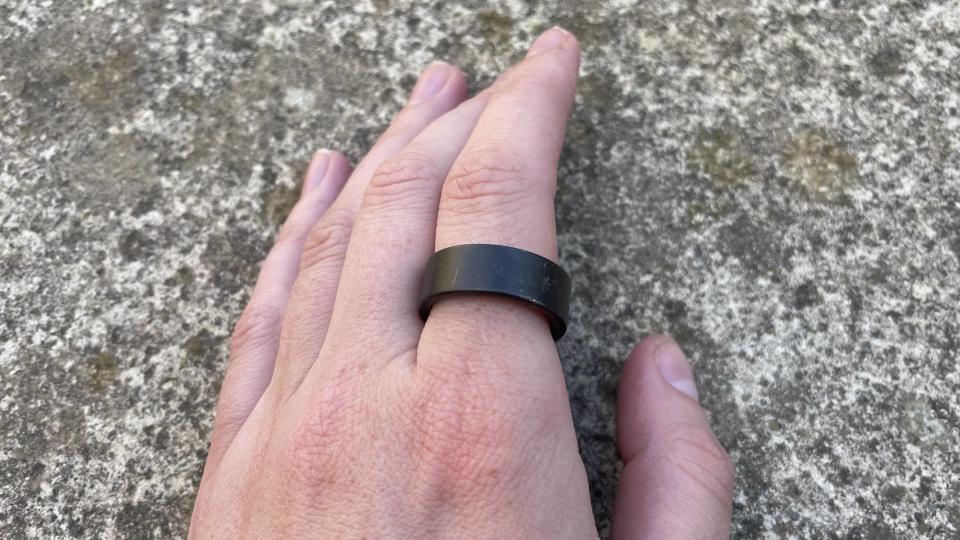
Lightweight from 2.4g to 3.6g
Very comfortable
Prone to scratching
When I first unpacked the UltraHuman Ring Air I was really impressed. This is an incredibly light, lovely-looking piece of tech that I forgot I was wearing often – a testament to how great it feels, especially at night. Depending on the size you get, it’s going to weigh between 2.4g and 3.6g. This is lighter than the latest Oura ring, which weighs between 4g and 6g, making it possibly the lightest wearable you can get these days.
The outer shell is made from fighter jet grade Titanium reinforced with Tungsten Carbide Carbon coating and has a classy-looking matte black finish. The inside is where the sensors live – it’s very cool to see these – but they’re covered by a see-through hypoallergenic epoxy resin coating, which feels very smooth and very comfortable. It’s also waterproof up to 100m, so you can wear it in the shower or swimming if you want to.
To ensure you get the right fit, UltraHuman will send out a testing kit. This feels quite wasteful to me, especially because I found the size to be the same as standard ring sizing. However, there are no half sizes here and testing the dummy rings that come with this kit might be a good way to see if this form factor is right for you – though they obviously feel cheaper and more plasticky than the final product.
One of the big problems with designing a device you wear on your finger 24/7 is just how much wear and tear it’ll experience. Despite the tough outer coating, you’ll see from the photos that it was significantly scratched after just a few weeks of wear.
Admittedly, I did wear it to the gym four times a week and will have been using equipment and metal dumbbells and barbells during that time – this is what I attribute most of the scratches to. But I expect it to be more gym-friendly given it’s aimed at those serious about training. Oddly, I quite liked the look of the scratches as they glinted in the sun, but some people will be disappointed by the wear. Especially because the matte black is the only option here – a silver version that’s the material under the coating might have been a good choice.
Again, it’s tricky to rate the UltraHuman Ring Air here. The design feels special right now and only the Oura rings come close. But the scratching means we’re going to need to dock a point here.
Design score: 4/5
UltraHuman Ring Air: Features
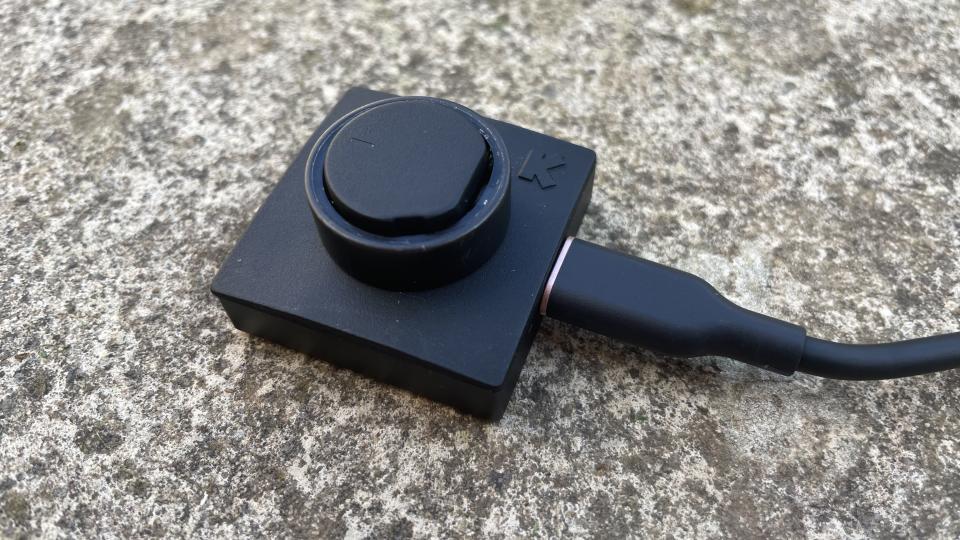
Loads of data
Similar to rivals’ metrics
No screen works well for me
There are several sensors built into the UltraHuman Ring Air that collect data about you, most notably your movement, skin temperature and heart rate. This information is then fed into the app and used to tell you all sorts about your health and fitness, including your steps, calories burned, time asleep, sleep quality, heart rate variability and more.
I like that the UltraHuman Ring Air interprets much of this data for you even further, presenting you with movement, sleep and recovery scores from the main homepage for a quick look at how you’re doing.
If you like, you can then dig further into this information. For example, click on your recovery score and you’ll see a trending graph over time, your resting heart rate, heart rate variability (HRV) and sleep data.
If you’re looking at the list of features and feel like there are a few key things missing, then they might be on the way soon. In August, the Ring Air will be getting two key updates, respiratory rate tracking. Which will help to identify your breathing efficiency and play into recovery information. As well as VO2 max, which UltraHuman says will provide “better fitness goal data and improve your cardiovascular endurance and fitness levels.”
There’s obviously no screen here, which means you need to check the app for everything. This does mean there were days when I simply forgot to look, but a lot of the benefits of these kinds of wearables comes with trending data over time anyway.
The lack of a screen was also refreshing for me. I felt less distracted by notifications throughout the day, which I’d always grin and bear when testing smartwatches and wrist-based activity trackers. But obviously that’s subjective and depends on what you’re looking for from a wearable. If it’s just data tracking, you’ve got plenty of that here and lots of features.
Features score: 4/5
UltraHuman Ring Air: Performance
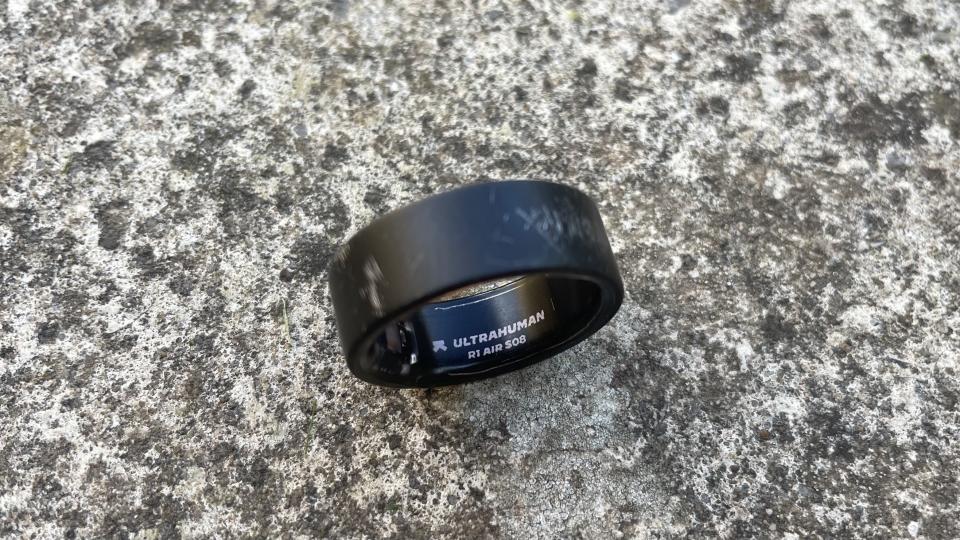
Accurate tracking
Handy scores
Quick syncing
One of the reasons smart rings are so appealing is that some of that all-important biometric data tends to be more accurate when the sensors are on your finger. That’s because the blood vessels in your fingers are much closer to the surface than those in your wrist.
I found the UltraHuman Ring Air performed well when compared to other wearables I had in for testing, collecting similar data to my Apple Watch Series 8 when it came to heart rate and steps. Considering so many recommendations made by the UltraHuman Ring Air app, it’s good to know the data it’s collecting in the first place is accurate.
As I’ve said a few times now, there’s a lot of data here to comb through. That’s why I only recommend the UltraHuman Ring Air for those who are genuinely going to be interested in looking at it. However, the easy-to-see scores mean you don’t have to be a biometric nerd to understand it, and the app has a simple (very Oura-like) homepage with cards for each type of data.
As well as these key scores, the app also serves up some really interesting information I’ve not seen presented so well from a wearable before and this is all to do with what time of the day you should do certain things. For example, there’s a sunlight exposure window as well as a caffeine intake window, essentially using information about your sleep and activity levels the app will recommend when you need to get outside and when it’s best to drink your morning cup of coffee so you feel good and don’t disrupt your sleep later in the day.
UltraHuman pulls in specific info about workouts from other apps, but it’s worth mentioning that there’s a workout mode from UltraHuman now too, which presents data and real-time tracking. This wasn’t live when I tested the ring, but the Ring Air did identify when I was working out several times based on my heart rate.
Anyone who’s keen to improve their training, find out more about their sleep and build positive new habits is bound to find huge benefits in seeing their data presented so thoroughly and clearly. If you just want a way to track your steps and the occasional workout, look at other options.
I personally struggle to regulate my energy levels and recovery, and I found the UltraHuman Ring Air’s recovery info and recommendations really handy for managing that. You could argue that outsourcing decisions about whether I work out intensely or not to a device isn’t healthy and I should be learning those signs myself, but I’m 36 so I’m ready to outsource it now after years of exhaustion, training too hard, and injuries.
UltraHuman says the Ring Air will last 6 days on a full charge and I found that to be almost spot on during my testing. It comes with a little charging stand that it slots onto and, once on there, it’ll take about 2 hours to charge back to 100%.
Performance score: 4/5
UltraHuman Ring Air: Scorecard
UltraHuman Ring Air: Should I buy?
Buy it if...
Don't buy it if...
Also consider
How we tested
I wore the UltraHuman Ring Air for a whole month connected to an iPhone 12. I only took it off for showers and charging. You can keep it on in the shower, but I was wary about soap, shampoo and getting it caught in my hair.
Wearing it 24/7 meant that it came on several work trips with me, I took it to work in coffee shops regularly, I wore it when working at home, I had it on at the gym, when I went for a swim in the sea and a run along the beach, out to dinner, on a few nights out and to my bed at home and in a few hotel rooms. Needless to say, it’s been tested a lot.
I’ve reviewed many wearables over the years and considering the smart ring market is new, I’ve had the chance to get my hands on (and fingers into) several iterations of the Oura Ring and tried an early version of the Motiv Ring back in 2017, too. This means I have some context about what to expect and how a smart ring should feel and work.
FIrst reviewed: August 2023

